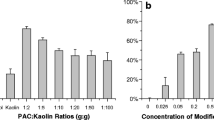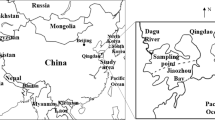Abstract
Microscopic propagules of Ulva species (UMPs) spread on Subei Shoal are believed to play a significant role in the formation of the Yellow Sea green tide. Previous laboratory and ship-based studies indicated that modified clay (MC) can effectively remove UMPs from the water column and restrict their germination. To evaluate the effectiveness of this method under natural conditions, a mesocosm experiment was conducted on the Zhugensha sandbank on Subei Shoal. The results show that the suspended particles on the sandbank would partially disturb the flocculation process between the MC and UMPs. However, the MC at a proper dose could effectively remove UMPs from the water column and decrease the adhesion and germination of UMPs on the nylon ropes that comprised the mariculture rafts by >75%. This method was proven a potential strategy to restrict the initial biomass accumulation of green algae on Subei Shoal. However, field trials in larger time-space scales are still needed to assess the efficiency of this method when used in the open sea.
Similar content being viewed by others
Data Availability Statement
All data generated and/or analyzed during the study are available from the corresponding author on reasonable request.
References
Ding L P, Fei X G, Lu Q Q, Deng Y Y, Lian S X. 2009. The possibility analysis of habitats, origin and reappearance of bloom green alga (Enteromorpha prolifera) on inshore of western Yellow Sea. Chinese Journal of Oceanology and Limnology, 27(3):421–424.
Gao S, Chen X Y, Yi Q Q, Wang G C, Pan G H, Lin A P, Peng G. 2010. A strategy for the proliferation of Ulva prolifera, main causative species of green tides, with formation of sporangia by fragmentation. PLoS One, 5(1): e8571.
Gao S, Zheng Z B, Gu W H, Xie X J, Huan L, Pan G H, Wang G C. 2014. Photosystem I shows a higher tolerance to sorbitol-induced osmotic stress than photosystem II in the intertidal macro-algae Ulva prolifera (Chlorophyta). Physiologia Plantarum, 152(2): 380–388.
Geng H X, Yan T, Zhou M J, Liu Q. 2015. Comparative study of the germination of Ulva prolifera gametes on various substrates. Estuarine, Coastal and Shelf Science, 163: 89–95.
Guillard R R L, Hargraves P E. 1993. Stichochrysis immobilis is a diatom, not a chrysophyte. Phycologia, 32(3): 234–236.
Haydon D A. 1961. The surface charge of cells and some other small particles as indicated by electrophoresis: I. The zeta potential-surface charge relationships. Biochimica et Biophysica Acta, 50(3): 450–457.
Huo Y Z, Hua L, Wu H L, Zhang J H, Cui J J, Huang X W, Yu K F, Shi H H, He P M, Ding D W. 2014. Abundance and distribution of Ulva microscopic propagules associated with a green tide in the southern coast of the Yellow Sea. Harmful Algae, 39: 357–364.
Keesing J K, Liu D Y, Fearns P, Garcia R. 2011. Inter- and intra-annual patterns of Ulva prolifera green tides in the Yellow Sea during 2007-2009, their origin and relationship to the expansion of coastal seaweed aquaculture in China. Marine Pollution Bulletin, 62(6): 1169–1182.
Kirby B J, Hasselbrink E F Jr. 2004. Zeta potential of microfluidic substrates: 1. Theory, experimental techniques, and effects on separations. Electrophoresis, 25 (2): 187–202.
Le Luherne E, Le Pape O, Murillo L, Randon M, Lebot C, Réveillac E. 2017. Influence of green tides in coastal nursery grounds on the habitat selection and individual performance of juvenile fish. PLoS One, 12(1): e0170110.
Lewis M A, Dantin D D, Walker C C, Kurtz J C, Greene R M. 2003. Toxicity of clay flocculation of the toxic dinoflagellate, Karenia brevis, to estuarine invertebrates and fish. Harmful Algae, 2(4): 235–246.
Li J, Song X X, Zhang Y, Pan J, Yu Z M. 2017. An investigation of the space distribution of Ulva microscopic propagules and ship-based experiment of mitigation using modifid clay. Marine Pollution Bulletin, 117(1-2): 247–254.
Li J, Song X X, Zhang Y, Xu X, Yu Z M. 2019. Effect of modified clay on the transition of paralytic shellfish toxins within the bay scallop Argopecten irradians and sediments in laboratory trials. Aquaculture, 505: 112–117.
Li J, Sun L, Song X X, Yu Z M. 2015. Removal of microscopic propagule and its germination of Ulva prolifera with modified clay. Oceanologia et Limnologia Sinica, 46(2): 345–350. (in Chinese with English abstract)
Li J, Sun L, Yu Z M, Song X X. 2016. Investigation on the efficiency of a silicone antifouling coating in controlling the adhesion and germination of Ulva prolifera micropropagules on rafts. Science China Earth Sciences, 60(2): 391–396.
Lin A P, Shen S D, Wang J W, Yan B L. 2008. Reproduction diversity of Enteromorpha prolifera. Journal of Integrative Plant Biology, 50(5): 622–629.
Lin A P, Wang C, Qiao H J, Pan G H, Wang G C, Song L Y, Wang Z Y, Sun S, Zhou B C. 2009. Study on the photosynthetic performances of Enteromorpha prolifera collected from the surface and bottom of the sea of Qingdao sea area. Chinese Science Bulletin, 54(3): 399–404.
Liu D Y, Keesing J K, Dong Z J, Zhen Y, Di B P, Shi Y J, Fearns P, Shi P. 2010a. Recurrence of the world's largest green-tide in 2009 in Yellow Sea, China: Porphyra yezoensis aquaculture rafts confirmed as nursery for macroalgal blooms. Marine Pollution Bulletin, 60(9): 1423–1432.
Liu D Y, Keesing J K, He P M, Wang Z L, Shi Y J, Wang Y J. 2013a. The world's largest macroalgal bloom in the Yellow Sea, China: formation and implications. Estuarine, Coastal and Shelf Science, 129: 2–10.
Liu D Y, Keesing J K, Xing Q U, Shi P. 2009. World's largest macroalgal bloom caused by expansion of seaweed aquaculture in China. Marine Pollution Bulletin, 58(6): 888–895.
Liu F, Feng S J, Shan T F, Xu N, Gao S Q, Sun S. 2010b. A novel method to quantify the microscopic stages of Ulva species in seawater and its applications in forcasting green tides of the Yellow Sea. Chinese Science Bulletin, 55(6): 468–473. (in Chinese with English abstract)
Liu F, Pang S J, Chopin T, Gao S Q, Shan T F, Zhao X B, Li J. 2013b. Understanding the recurrent large-scale green tide in the Yellow sea: temporal and spatial correlations between multiple geographical, aquacultural and biological factors. Marine Environmental Research, 83: 38–47.
Liu F, Pang S J, Zhao X B, Hu C M. 2012. Quantitative, molecular and growth analyses of Ulva microscopic propagules in the coastal sediment of Jiangsu province where green tides initially occurred. Marine Environmental Research, 74: 56–63.
Liu Q, Yu R C, Yan T, Zhang Q C, Zhou M J. 2015. Laboratory study on the life history of bloom-forming Ulva prolifera in the Yellow sea. Estuarine, Coastal and Shelf Science, 163: 82–88.
Liu S Y, Yu Z M, Song X X, Cao X H. 2017. Effects of modified clay on the physiological and photosynthetic activities of Amphidinium carterae Hulburt. Harmful Algae, 70: 64–72.
Mei Z H, Zhang Z H, Zhao C X, Xu M, Li M. 2010. Dynamics of phytoplankton and water quality with control of cyanobacterial bloom in lake Xuanwu, Nanjing. Journal of Lake Sciences, 22(1): 44–48. (in Chinese with English abstract)
Pang S J, Liu F, Shan T F, Xu N, Zhang Z H, Gao S Q, Chopin T, Sun S. 2010. Tracking the algal origin of the Ulva bloom in the Yellow sea by a combination of molecular, morphological and physiological analyses. Marine Environmental Research, 69(4): 207–215.
Pieterse A J H, Cloot A. 1997. Algal cells and coagulation, flocculation and sedimentation processes. Water Science and Technology, 36(4): 111–118.
Sengco M R, Hagstrom J A, Granéli E, Anderson D M. 2005. Removal of Prymnesium parvum (Haptophyceae) and its toxins using clay minerals. Harmful Algae, 4(2): 261–274.
Song W, Jiang M J, Wang Z L, Wang H P, Zhang X L, Fu M Z. 2018. Source of propagules of the fouling green macroalgae in the Subei Shoal, China. Acta Oceanologica Sinica, 37(4): 102–108.
Wang X K, Ma J H, Ye D C, Chen X D. 2007. Preliminary study on the life history of Enteromorpha prolifera. Marine Science Bulletin, 26(5): 112–116. (in Chinese with English abstract)
Wang Z F, Yu Z M, Song X X, Cao X H, Liu K. 2014. Impact of modified clay on the growth of the infant Apostichopus japonicas Selenka in HABs controling. Oceanologia et Limnologia Sinica, 45(2): 233–238. (in Chinese with English abstract)
Ye N H, Zhang X W, Mao Y Z, Liang C W, Xu D, Zou J, Zhuang Z M, Wang Q Y. 2011. ‘Green tides’ are overwhelming the coastline of our blue planet: taking the world's largest example. Ecological Research, 26(3): 477–485.
Yu Z M, Ma X N, Xie Y. 1995. Study of main nutrients adsorption on clays in seawater. Oceanologia et Limnologia Sinica, 26(2): 208–214. (in Chinese with English abstract)
Yu Z M, Song X X, Cao X H, Liu Y. 2017. Mitigation of harmful algal blooms using modified clays: Theory, mechanisms, and applications. Harmful Algae, 69: 48–64.
Yu Z M, Zou J Z, Ma X N. 1994. A new method to improve the capability of clays for removing red tide organisms. Oceanologia et Limnologia Sinica, 25(2): 226–232. (in Chinese with English abstract)
Zhang Y, Song X X, Li J, Cao X H, Yu Z M. 2016. Effect of different modified clay on the removal and germination of Ulva prolifera microscopic propagules. Haiyang Xuebao, 38(8): 93–102. (in Chinese with English abstract)
Zhou M J, Liu D Y, Anderson D M, Valiela I. 2015a. Introduction to the special issue on green tides in the Yellow sea. Estuarine, Coastal and Shelf Science, 163: 3–8.
Zhou Y P, Tan L J, Pang Q T, Li F, Wang J T. 2015b. Influence of nutrients pollution on the growth and organic matter output of Ulva prolifera in the southern Yellow Sea, China. Marine Pollution Bulletin, 95(1): 107–114.
Author information
Authors and Affiliations
Corresponding author
Additional information
Supported by the AoShan Technological Innovation Program from Qingdao National Laboratory for Marine Science and Technology (No. 2016ASKJ02-1), the Taishan Scholars Climbing Program of Shandong Province of 2019, and the Marine S&T Fund of Shandong Province for Pilot National Laboratory for Marine Science and Technology (Qingdao) (No. 2019SDKJ0504-2).
Rights and permissions
About this article
Cite this article
Li, J., Song, X., Fan, X. et al. Flocculation of Ulva microscopic propagules using modified clay: a mesocosm experiment. J. Ocean. Limnol. 38, 1283–1291 (2020). https://doi.org/10.1007/s00343-020-9348-6
Received:
Accepted:
Published:
Issue Date:
DOI: https://doi.org/10.1007/s00343-020-9348-6




